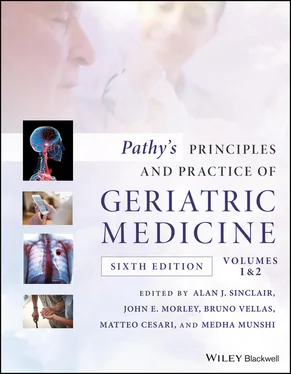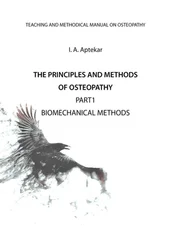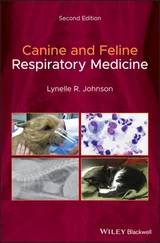Pathy's Principles and Practice of Geriatric Medicine
Здесь есть возможность читать онлайн «Pathy's Principles and Practice of Geriatric Medicine» — ознакомительный отрывок электронной книги совершенно бесплатно, а после прочтения отрывка купить полную версию. В некоторых случаях можно слушать аудио, скачать через торрент в формате fb2 и присутствует краткое содержание. Жанр: unrecognised, на английском языке. Описание произведения, (предисловие) а так же отзывы посетителей доступны на портале библиотеки ЛибКат.
- Название:Pathy's Principles and Practice of Geriatric Medicine
- Автор:
- Жанр:
- Год:неизвестен
- ISBN:нет данных
- Рейтинг книги:3 / 5. Голосов: 1
-
Избранное:Добавить в избранное
- Отзывы:
-
Ваша оценка:
- 60
- 1
- 2
- 3
- 4
- 5
Pathy's Principles and Practice of Geriatric Medicine: краткое содержание, описание и аннотация
Предлагаем к чтению аннотацию, описание, краткое содержание или предисловие (зависит от того, что написал сам автор книги «Pathy's Principles and Practice of Geriatric Medicine»). Если вы не нашли необходимую информацию о книге — напишите в комментариях, мы постараемся отыскать её.
Pathy’s Principles and Practice of Geriatric Medicine
Pathy's Principles and Practice of Geriatric Medicine — читать онлайн ознакомительный отрывок
Ниже представлен текст книги, разбитый по страницам. Система сохранения места последней прочитанной страницы, позволяет с удобством читать онлайн бесплатно книгу «Pathy's Principles and Practice of Geriatric Medicine», без необходимости каждый раз заново искать на чём Вы остановились. Поставьте закладку, и сможете в любой момент перейти на страницу, на которой закончили чтение.
Интервал:
Закладка:
Haematopoietic stem cell transplantation
The only possible definitive cure for MDS is represented by allogeneic HSCT. 81‐83For many years, older age was considered per se a contraindication to transplant, mainly because of the intensive, myeloablative conditioning chemotherapeutic regimens used. The development of reduced‐intensity conditioning approaches has made HSCT an option even for fit older adults. This treatment modality seeks to maximize the immune effect of graft versus leukaemia while minimizing the toxicity associated with ablative conditioning regimens. Non‐myeloablative transplantation has a low short‐term mortality rate in patients with MDS up to age 70–75 with overall survival rates comparable to those for ablative transplantation, mainly due to the higher risk of relapse. 84
In a large retrospective study conducted in the US, 1106 patients ≥70 underwent HSCT. The proportion of allogenic HSCT increased over time (from 0.1% in 2000 to 3.85% in 2013; total number: 298). Acute myeloid leukaemia and myelodysplastic syndromes represented the most common disease indications. Two‐year OS and PFS significantly improved over time (OS: 26% in 2000–2007 to 39% in 2008–2013; PFS: 22% in 2000–2007 to 32% in 2008–2013, P = .003). Two‐year treatment‐related mortality ranged remained unchanged over time (33–35%). Higher comorbidity and myeloablative conditioning were associated with higher mortality rates. 102
Again, undertaking CGA is crucial in selecting the candidates for transplantation.
Key points
Myelodysplastic syndromes (MDS) are a heterogeneous group of clonal stem cell disorders characterized by dysplasia, ineffective haematopoiesis, and potential risk of transformation into acute leukaemia.
In MDS, the important predictors for overall prognoses are cytogenetic abnormalities, percentage of myeloblasts in the bone marrow, and number of lineages that exhibit cytopenias.
Because the defect in MDS occurs in an early haematopoietic precursor, allogeneic transplant represents a potentially curative option.
References
1 1. Chudwin DS, Cowan MJ, Greenberg PL, Wara DW, Ammann AJ. Response of agranulocytosis to prolonged antithymocyte globulin therapy. J Pediatr. 1983; 103(2):223–227. doi:10.1016/s0022‐3476(83)80349‐7
2 2. Greenberg PL. The smoldering myeloid leukemic states: clinical and biologic features. Blood. 1983; 61(6):1035–1044.
3 3. Levine E.G. Bloomfield CD. Leukemias and myelodysplastic syndromes secondary to drug, radiation, and environmental exposure. Semin Oncol. 1992; 19(1):47–84.
4 4. Dahl G, Werner R, Levine E, Rabadan‐Diehl C. Mutational analysis of gap junction formation. Biophys J. 1992; 62(1):172–182. doi:10.1016/S0006‐3495(92)81803‐9
5 5. Germing U, Gattermann N, Minning H, Heyll A, Aul C. Problems in the classification of CMML‐‐dysplastic versus proliferative type. Leuk Res. 1998; 22(10):871–878. doi:10.1016/s0145‐2126(97)00192‐6
6 6. Greenberg P, Cox C, LeBeau MM, et al. International scoring system for evaluating prognosis in myelodysplastic syndromes. Blood. 1997; 89(6):2079–2088. doi:10.1182/blood.v89.6.2079
7 7. Malcovati L, Hellström‐Lindberg E, Bowen D, et al. Diagnosis and treatment of primary myelodysplastic syndromes in adults: Recommendations from the European LeukemiaNet. Blood. 2013; 122(17):2943–2964. doi:10.1182/blood‐2013‐03‐492884
8 8. Knickman JR, Snell EK. The 2030 problem: Caring for aging baby boomers. Health Serv Res. 2002; 37(4):849–884. doi:10.1034/j.1600‐0560.2002.56.x
9 9. Stauder R. The challenge of individualised risk assessment and therapy planning in elderly high‐risk myelodysplastic syndromes (MDS) patients. Ann Hematol. 2012; 91(9):1333–1343. doi:10.1007/s00277‐012‐1472‐8
10 10. Aul C, Gattermann N. The role of low‐dose chemotherapy in myelodysplastic syndromes. Leuk Res. 1992; 16(3):207–215. doi:10.1016/0145‐2126(92)90058‐f
11 11. Ma X, Does M, Raza A, Mayne ST. Myelodysplastic syndromes: Incidence and survival in the United States. Cancer. 2007; 109(8):1536–1542. doi:10.1002/cncr.22570
12 12. Rollison DE, Howlader N, Smith MT, et al. Epidemiology of myelodysplastic syndromes and chronic myeloproliferative disorders in the United States, 2001‐2004, using data from the NAACCR and SEER programs. Blood. 2008; 112(1):45–52. doi:10.1182/blood‐2008‐01‐134858
13 13. Cogle CR, Craig BM, Rollison DE, List AF. Incidence of the myelodysplastic syndromes using a novel claims‐based algorithm: High number of uncaptured cases by cancer registries. Blood. 2011; 117(26):7121–7125. doi:10.1182/blood‐2011‐02‐337964
14 14. Goldberg SL, Chen E, Corral M, et al. Incidence and clinical complications of myelodysplastic syndromes among United States Medicare beneficiaries. J Clin Oncol. 2010; 28(17):2847–2852. doi:10.1200/JCO.2009.25.2395
15 15. Pedersen‐Bjergaard J, Philip P. Balanced translocations involving chromosome bands 11q23 and 21q22 are highly characteristic of myelodysplasia and leukemia following therapy with cytostatic agents targeting at DNA‐topoisomerase II. Blood. 1991; 78(4):1147–1148.
16 16. Pomeroy C, Oken MM, Rydell RE, Filice GA. Infection in the myelodysplastic syndromes. Am J Med. 1991; 90(1):338–344. doi:10.1016/0002‐9343(91)90574‐H
17 17. Boogaerts MA, Nelissen V, Roelant C, Goossens W. Blood neutrophil function in primary myelodysplastic syndromes. Br J Haematol. 1983; 55(2):217–227. doi:10.1111/j.1365‐2141.1983.tb01241.x
18 18. Greenberg PL, Tuechler H, Schanz J, et al. Revised international prognostic scoring system for myelodysplastic syndromes. Blood. 2012; 120(12):2454–2465. doi:10.1182/blood‐2012‐03‐420489
19 19. della Porta MG, Malcovati L, Strupp C, et al. Risk stratification based on both disease status and extra‐hematologic comorbidities in patients with myelodysplastic syndrome. Haematologica. 2011; 96(3):441–449. doi:10.3324/haematol.2010.033506
20 20. Naqvi K, Garcia‐Manero G, Sardesai S, et al. Association of comorbidities with overall survival in myelodysplastic syndrome: Development of a prognostic model. J Clin Oncol. 2011; 29(16):2240–2246. doi:10.1200/JCO.2010.31.3353
21 21. Van Spronsen MF, Ossenkoppele GJ, Holman R, Van De Loosdrecht AA. Improved risk stratification by the integration of the revised International Prognostic Scoring System with the Myelodysplastic Syndromes Comorbidity Index. Eur J Cancer. 2014; 50(18):3198–3205. doi:10.1016/j.ejca.2014.09.016
22 22. Daver N, Naqvi K, Jabbour E, et al. Impact of comorbidities by ACE‐27 in the revised‐IPSS for patients with myelodysplastic syndromes. Am J Hematol. 2014; 89(5):509–516. doi:10.1002/ajh.23675
23 23. Balleari E, Salvetti C, Del Corso L, et al. Age and comorbidities deeply impact on clinical outcome of patients with myelodysplastic syndromes. Leuk Res. 2015; 39(8):846–852. doi:10.1016/j.leukres.2015.05.007
24 24. Hurria A, Mohile S, Gajra A, et al. Validation of a Prediction Tool for Chemotherapy Toxicity in Older Adults With Cancer. J Clin Oncol. 2016; 34(20). doi:10.1200/JCO.2015.65.4327
25 25. Van Der Walde N, Jagsi R, Dotan E, et al. Older adult oncology, version 2.2016: Featured updates to the NCCN guidelines. JNCCN J Natl Compr Cancer Netw. 2016; 14(11):1357–1370. doi:10.6004/jnccn.2016.0146
26 26. Fried LP, Ferrucci L, Darer J, Williamson JD, Anderson G. Untangling the concepts of disability, frailty, and comorbidity: implications for improved targeting and care. J Gerontol A Biol Sci Med Sci. 2004; 59(3):255–263. doi:10.1093/gerona/59.3.m255
27 27. Hamaker ME, Schiphorst AH, ten Bokkel Huinink D, Schaar C, van Munster BC. The effect of a geriatric evaluation on treatment decisions for older cancer patients – a systematic review. Acta Oncol (Madr). 2014; 53(3):289–296. doi:10.3109/0284186X.2013.840741
Читать дальшеИнтервал:
Закладка:
Похожие книги на «Pathy's Principles and Practice of Geriatric Medicine»
Представляем Вашему вниманию похожие книги на «Pathy's Principles and Practice of Geriatric Medicine» списком для выбора. Мы отобрали схожую по названию и смыслу литературу в надежде предоставить читателям больше вариантов отыскать новые, интересные, ещё непрочитанные произведения.
Обсуждение, отзывы о книге «Pathy's Principles and Practice of Geriatric Medicine» и просто собственные мнения читателей. Оставьте ваши комментарии, напишите, что Вы думаете о произведении, его смысле или главных героях. Укажите что конкретно понравилось, а что нет, и почему Вы так считаете.












